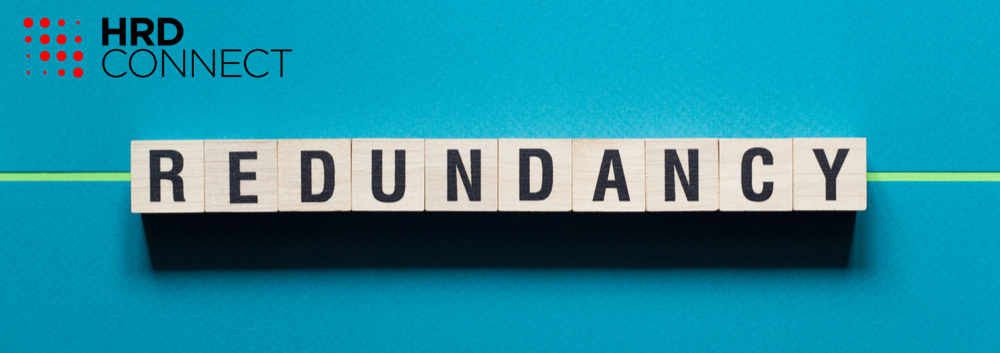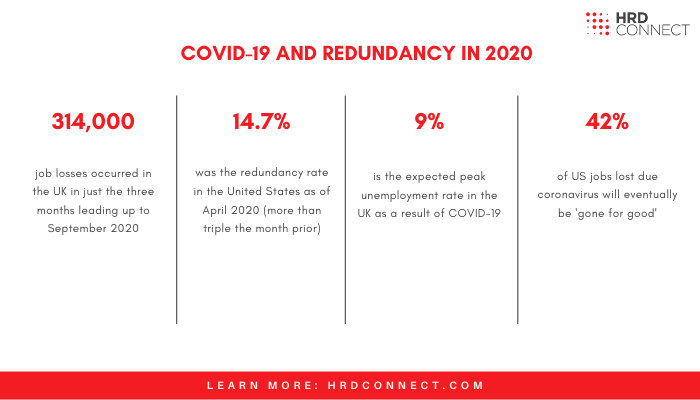HRD Deep Dive: Redundancy in 2020 - what do HR leaders need to know?
- 6 Min Read
In this edition of HRD Deep Dive, we tackle the all-too-familiar issue of redundancy, and how employers can adequately prepare themselves for the worst during a time of economic hardship.
- Author: Sam Alberti
- Date published: Nov 26, 2020
- Categories

As we approach the 2020 Christmas period, there finally appears to be light at the end of tunnel. At the time of writing, there are currently six, fully-developed COVID-19 vaccines that have been proven to be highly-effective, and have subsequently been cleared for early or limited use. Though it goes without saying, this is a development of astronomical significance, and collective sighs of relief are being let out the world over.
However, with the blight that has been inflicted by the pandemic for the past nine months, the unfortunate reality is that in many cases, a great deal of damage has already been done. With burgeoning infection rates severely impacting labor and supply chains, and government-imposed restrictions diminishing custom and revenue, the economic impact of coronavirus is self-explanatory.
As a result, redundancy and unemployment are both soaring to untold heights in many of the world’s major regions. The UK, for example, has seen 314,000 job losses in just the three months leading up to September, with the overall unemployment rate being expected to peak at 9% before the end of the pandemic. Similarly, in the United States, the rate more than tripled between March and April this year, rising by over 10 percentage points to 14.7%.
With further economic damage expected in the coming months, redundancy is something that all HR professionals must consider and prepare for.
Compassion in a redundancy situation
It’s one thing to conduct a redundancy procedure in a manner that checks all of the right administrative boxes and adheres to legal guidelines, but to do so in a manner that genuinely protects the interests of the individual is another thing entirely.
The events of 2020 have rendered this topic particularly pertinent, not only due to the increased likelihood of redundancy, but because of the intensified awareness of employee wellbeing (and particularly mental health) across the industry. In fact, one study conducted earlier this year found that 94% of companies have increased their wellbeing spend as a direct result of COVID-19, with 72% saying that their employees have directly raised at least one wellbeing issue during the pandemic.
What’s more, with the damage that has been inflicted on the economy and the job market, the impact of a job loss now has the potential to be even more damaging to an individual than ever before. Not only are jobs being lost, but in many cases they are being eradicated completely, with one study painting the grim picture that 42% of US jobs lost due to COVID will eventually be gone for good.
“We know that there is a link between issues like job insecurity, financial worries, unemployment, and mental health,” said Emma Mamo, head of workplace wellbeing at Mind, in an interview with The Telegraph. “Those facing redundancies could be at greater risk of worsening mental health.”
With this in mind, the spectre of redundancy should be approached all the more delicately by employers, and the HR function undoubtedly has a pivotal role to play in doing this. Redundancy may be an inevitability in many cases, but that certainly doesn’t mean that leaders can’t take steps to mitigate the damage.
The issue is summarized in a nutshell in guidance published by CIPD. “It is important that every employer approaches a redundancy process with compassion and treats everyone with dignity, respect and kindness. Handling redundancy in a humane and compassionate way can make a significant difference to how people cope with the process,” it said.
The guidance went on to directly address the concerns surrounding mental health, and detailed how these can be tackled. It said: “Being selected for redundancy can have a significant detrimental impact on someone’s mental health. Immediate and ongoing support should be available to the individual to support their health and wellbeing.”

The bureaucratic angle
To gain some insight on the matter from a different perspective, HRD Connect spoke with James Tamm, Head of Legal Services, Ellis Whittam. Tamm largely echoed the concerns raised in CIPD’s guidance, but went on to place them into a legal context.
He said: “A redundancy process is one of the most difficult tasks undertaken by employers. It can often result in widespread disruption, with employees becoming distracted by the process, often at a time when there is a need to make sure business as usual continues.
“Employees worried about the outcome often start looking elsewhere for work which can result in an exodus of key talent. If a large number of employees are to be dismissed, it also exposes organizations to a great deal of risk, as redundant employees will often look to make claims against their former employers.”
Aside from the more familiar complications for employees, Tamm also touched on some key issues that employers could potentially face. Most notably, the risk of other key talent choosing to leave the organization due to the stress and uncertainty caused, and the potential for legal action to be brought by redundant employees. It goes without saying that in these circumstances, particularly during a pandemic, the overall health of the organization could be compromised.
Offering some guidance on how these challenges could be mitigated, Tamm said: “It is key in any redundancy situation to have a really clear plan about what you are trying to achieve. You many needs to consider areas such as where in the business savings need to be made, how many redundancies may be necessary, the method for selecting those unfortunate employees, and even whether redundancy is really necessary.
“Once you have your plan, you need to have a clear strategy for communicating it to your workforce. In my experience, employees tend to be less inclined towards litigation if they understand what is happening and why. A failure to properly explain, perhaps resulting in a message that looks like a sham or doesn’t stand up to scrutiny, will only arouse suspicion among those eventually made redundant.”
The outlook
Despite the advent of groundbreaking vaccines expected to occur in the coming months, the fact still remains that for many organizations, there could still be a world of economic complication yet to come.
As a result, HR leaders must stand by and prepare to tackle redundancy in a manner that utilizes the entire gamut of progressive people leadership practices that have been so heavily discussed since the emergence of COVID-19; compassionate and transparent leadership, a caring, considerate approach from the organization, and a general appreciation of the significance of wellbeing among employees.
If executed correctly, not only can businesses safeguard the interests of the individual, but they can potentially also prevent a series of pitfalls that could harm the organization in the long run.









